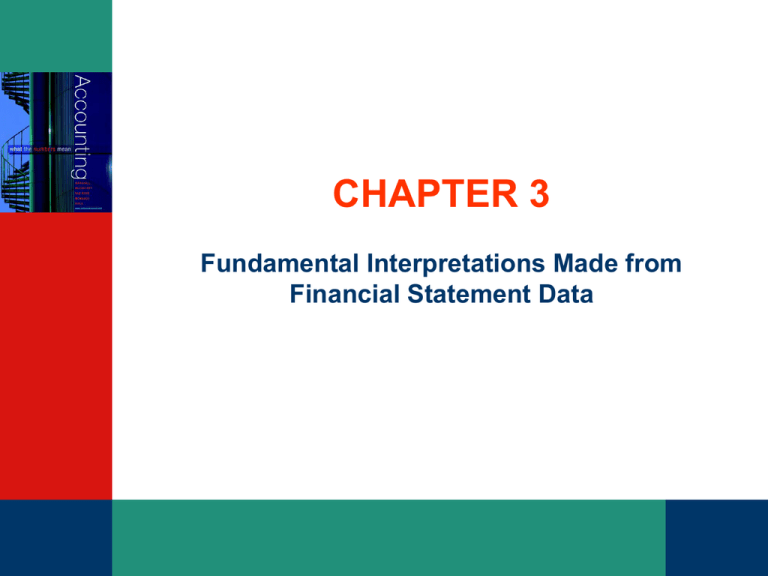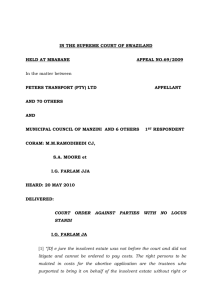Chapter 3
advertisement

CHAPTER 3 Fundamental Interpretations Made from Financial Statement Data Overview • Financial ratios and trend analysis • Return on assets • ROA - The Dupont model • Return on equity • Liquidity, working capital and ratios • Trend analysis PowerPoint Slides t/a Accounting: What the Numbers Mean Marshall, McCartney, van Rhyn, McManus, Viele Slides prepared by Sandra Chapple Copyright 2005 McGraw-Hill Australia Pty Ltd 3-2 Financial Ratios and Trend Analysis A ratio is simply the relationship between two numbers. The large dollar amounts reported on the financial statements of many companies, and the varying size of companies, make ratio analysis the only sensible method of evaluating various financial characteristics. PowerPoint Slides t/a Accounting: What the Numbers Mean Marshall, McCartney, van Rhyn, McManus, Viele Slides prepared by Sandra Chapple Copyright 2005 McGraw-Hill Australia Pty Ltd 3-3 Financial Ratios and Trend Analysis A single ratio is not very useful in describing a company. Trend analysis compares a single observation over several years. PowerPoint Slides t/a Accounting: What the Numbers Mean Marshall, McCartney, van Rhyn, McManus, Viele Slides prepared by Sandra Chapple Copyright 2005 McGraw-Hill Australia Pty Ltd 3-4 Financial Ratios and Trend Analysis Trend Analysis Also used for comparison of company ratios with those of other companies in same industry PowerPoint Slides t/a Accounting: What the Numbers Mean Marshall, McCartney, van Rhyn, McManus, Viele Slides prepared by Sandra Chapple Copyright 2005 McGraw-Hill Australia Pty Ltd Industry average ratios Company’s relative standing in the industry 3-5 Return on Assets Rate of = Return Amount of Return Amount of Investment This ratio provides the return on a given investment alternative. All other things being equal, the higher the rate of return, the more profitable the alternative. Useful to compare different and unequal investments. PowerPoint Slides t/a Accounting: What the Numbers Mean Marshall, McCartney, van Rhyn, McManus, Viele Slides prepared by Sandra Chapple Copyright 2005 McGraw-Hill Australia Pty Ltd 3-6 Return on Assets Higher risk – investor anticipates higher ROR PowerPoint Slides t/a Accounting: What the Numbers Mean Marshall, McCartney, van Rhyn, McManus, Viele Slides prepared by Sandra Chapple Copyright 2005 McGraw-Hill Australia Pty Ltd 3-7 Return on Assets Rate of = Return Amount of Return Amount of Investment The rate of return calculation is derived from the interest calculation. Interest = Principal × Rate × Time PowerPoint Slides t/a Accounting: What the Numbers Mean Marshall, McCartney, van Rhyn, McManus, Viele Slides prepared by Sandra Chapple Copyright 2005 McGraw-Hill Australia Pty Ltd 3-8 Return on Assets RETURN ON ASSETS • rate of return using data from financial statements • sometimes called return on investments PowerPoint Slides t/a Accounting: What the Numbers Mean Marshall, McCartney, van Rhyn, McManus, Viele Slides prepared by Sandra Chapple Copyright 2005 McGraw-Hill Australia Pty Ltd 3-9 Return on Assets Return on = Assets Income from operations Average Total Assets This ratio describes the rate of return management was able to earn on the assets that it had available during the year. An informed judgement about the firm’s profitability requires relating income from operations to the assets used to generate that net profit. PowerPoint Slides t/a Accounting: What the Numbers Mean Marshall, McCartney, van Rhyn, McManus, Viele Slides prepared by Sandra Chapple Copyright 2005 McGraw-Hill Australia Pty Ltd 3-10 Return on Assets Income from operations EBIT – Earnings Before Income and Tax PowerPoint Slides t/a Accounting: What the Numbers Mean Marshall, McCartney, van Rhyn, McManus, Viele Slides prepared by Sandra Chapple Copyright 2005 McGraw-Hill Australia Pty Ltd Total return to all providers of finance without the complications of tax 3-11 ROA - The DuPont Model The DuPont Model is an expansion of the basic ROA calculation. Return on = Assets EBIT Sales Margin × Sales Average Total Assets Turnover Profitability from sales and utilisation of assets to generate sales revenue are both important factors to be considered when evaluating profitability. PowerPoint Slides t/a Accounting: What the Numbers Mean Marshall, McCartney, van Rhyn, McManus, Viele Slides prepared by Sandra Chapple Copyright 2005 McGraw-Hill Australia Pty Ltd 3-12 The DuPont Model Return on = Assets EBIT Sales × AverageSales Total Assets Margin Emphasises that from every dollar of sales revenue, some amount must work its way to net profit. Turnover Relates efficiency with which the firm’s assets are used in the revenuegenerating process. PowerPoint Slides t/a Accounting: What the Numbers Mean Marshall, McCartney, van Rhyn, McManus, Viele Slides prepared by Sandra Chapple Copyright 2005 McGraw-Hill Australia Pty Ltd 3-13 The DuPont Model Return on = Assets EBIT Sales Sales × Average Total Assets Margin Turnover A rule of thumb useful for putting ROA in perspective is that average ROA, based on net profit, for most global merchandising and manufacturing companies is between 8% and 12%. PowerPoint Slides t/a Accounting: What the Numbers Mean Marshall, McCartney, van Rhyn, McManus, Viele Slides prepared by Sandra Chapple Copyright 2005 McGraw-Hill Australia Pty Ltd 3-14 Return on Equity Return on = Equity Net Profit (after tax) Average Owners’ Equity Owners are interested in expressing the profits of the firm as a rate of return on the amount of owners’ equity. As a rule of thumb, average ROE for most global merchandising and manufacturing companies has historically ranged from 10% to 15%. PowerPoint Slides t/a Accounting: What the Numbers Mean Marshall, McCartney, van Rhyn, McManus, Viele Slides prepared by Sandra Chapple Copyright 2005 McGraw-Hill Australia Pty Ltd 3-15 Liquidity and Working Capital Liquidity Firm’s ability to meet current obligations Measured in three ways: 1. Working capital 2. Current ratio 3. Quick ratio PowerPoint Slides t/a Accounting: What the Numbers Mean Marshall, McCartney, van Rhyn, McManus, Viele Slides prepared by Sandra Chapple Copyright 2005 McGraw-Hill Australia Pty Ltd 3-16 Liquidity and Working Capital Working capital Current assets - Current liabilities Working capital Working capital is the excess of a firm’s current assets over its current liabilities. PowerPoint Slides t/a Accounting: What the Numbers Mean Marshall, McCartney, van Rhyn, McManus, Viele Slides prepared by Sandra Chapple Copyright 2005 McGraw-Hill Australia Pty Ltd 3-17 Liquidity and Working Capital Current ratio Current ratio = Current assets Current liabilities This ratio measures the ability of the company to pay current debts as they become due. As a rule of thumb, a current ratio of 2.0 is considered indicative of adequate liquidity. PowerPoint Slides t/a Accounting: What the Numbers Mean Marshall, McCartney, van Rhyn, McManus, Viele Slides prepared by Sandra Chapple Copyright 2005 McGraw-Hill Australia Pty Ltd 3-18 Liquidity and Working Capital Current ratio – need to balance: Debtpaying ability PowerPoint Slides t/a Accounting: What the Numbers Mean Marshall, McCartney, van Rhyn, McManus, Viele Slides prepared by Sandra Chapple Copyright 2005 McGraw-Hill Australia Pty Ltd Most productive use of assets 3-19 Liquidity and Working Capital Acid-test ratio Acid-test = ratio Quick assets Current liabilities Quick assets are cash (including temporary cash investments) and accounts receivable. This ratio provides information about an almost worst-case situation—the firm’s ability to meet its current obligations even if none of the inventory can be sold. As a rule of thumb, an acid-test ratio of 1.0 is considered indicative of adequate liquidity. PowerPoint Slides t/a Accounting: What the Numbers Mean Marshall, McCartney, van Rhyn, McManus, Viele Slides prepared by Sandra Chapple Copyright 2005 McGraw-Hill Australia Pty Ltd 3-20 Trend Analysis Example PRIMARY HEALTH CARE LTD Figures come from the published financial statements. Data is presented in tables and graphs on the following slides: PowerPoint Slides t/a Accounting: What the Numbers Mean Marshall, McCartney, van Rhyn, McManus, Viele Slides prepared by Sandra Chapple Copyright 2005 McGraw-Hill Australia Pty Ltd 3-21 Trend Analysis Primary Health Care Group Profitability and Liquidity Data 1999-2003 2003 2002 2001 2000 1999 7% 0.63 4.40% 7% 6% 0.45 2.50% 5% 7% 0.47 3.30% 6% 8% 0.56 4.40% 7% 11% 0.59 6.60% 0% 66407 18158 48249 3.66 54070 15022 39048 3.60 23855 19249 4606 1.24 8684 18850 -10166 0.46 Ratios Margin Turnover ROA ROE Year end position (millions) Current assets Current liabilities Working Capital Current ratio 22113 16464 5649 1.34 PowerPoint Slides t/a Accounting: What the Numbers Mean Marshall, McCartney, van Rhyn, McManus, Viele Slides prepared by Sandra Chapple Copyright 2005 McGraw-Hill Australia Pty Ltd 3-22 Trend Analysis PRIMARY HEALTH CARE GROUP LTD, RETURN ON ASSETS (ROA) AND RETURN ON EQUITY (ROE), 1999-2003 14% Return (%) 12% 10% 8% 6% 4% 2% 0% 1999 2000 2001 2002 2003 Years ended 30 June ROA ROE Declining profitability with slight improvement in 2003, although not as high as returns before the company went public in 1999. PowerPoint Slides t/a Accounting: What the Numbers Mean Marshall, McCartney, van Rhyn, McManus, Viele Slides prepared by Sandra Chapple Copyright 2005 McGraw-Hill Australia Pty Ltd 3-23 Trend Analysis Turnover 0.8 0.6 0.4 0.2 0 1999 2000 2001 2002 Years ended June 30 Margin 12% 10% 8% 6% 4% 2% 0% 2003 Margin (%) PRIMARY HEALTH CARE GROUP LTD, MARGIN AND TURNOVER, 1999-2003 Steady decline of turnover and margin until 2002, with slight recovery in 2003. Turnover Be aware of the impact of scales selected. PowerPoint Slides t/a Accounting: What the Numbers Mean Marshall, McCartney, van Rhyn, McManus, Viele Slides prepared by Sandra Chapple Copyright 2005 McGraw-Hill Australia Pty Ltd 3-24 Trend Analysis 1999 2000 2001 2002 Current Ratio -1 -0 0. 0. 1. 1. 2. 2. 3. 3. 4. .0 .5 00 50 00 50 00 50 00 50 00 0 0 Working Capital $m 80 70 60 50 40 30 20 10 0 -1 0 -2 0 PRIMARY HEALTH CARE LTD, WORKING CAPITAL AND CURRENT RATIO, 1999-2003 2003 Years Ended June 30 Working Capital Current ratio Decline in working capital and current ratio in 2003, but increase in turnover, margins and returns. PowerPoint Slides t/a Accounting: What the Numbers Mean Marshall, McCartney, van Rhyn, McManus, Viele Slides prepared by Sandra Chapple Copyright 2005 McGraw-Hill Australia Pty Ltd 3-25



